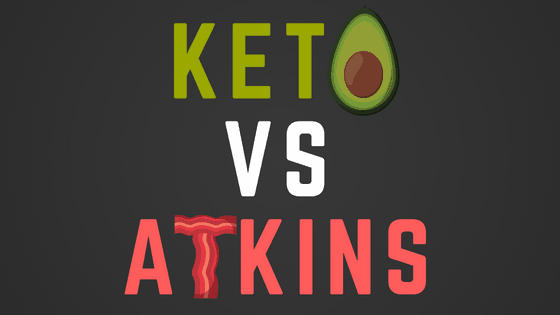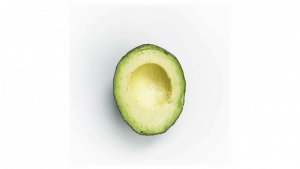We’ve been receiving this question a lot from readers: What exactly is the difference between the keto diet and the Atkins diet?
It’s an extremely fair question considering both are highly popular low carb diets. So what exactly makes them different? Let’s dig into our comparison of the keto diet vs Atkins diet.
Keto Diet vs Atkins Diet
1) “Low” carbohydrate diets

Both the keto and Atkins diets are low carbohydrate diets. However, the operative word here is low. Low is a relative term and can apply to a wide range of net carbs consumed daily.
Keto recommends 20g net carbs daily
For the keto diet specifically, the goal is for the body to enter the state of ketosis by severely limiting carbohydrate intake.
While the amount varies between individuals, the generally-recommended target daily intake of net carbohydrates on a ketogenic diet is 20g.
This intake level of carbohydrates encourages the body to break down fat and convert it into ketone bodies, which can be used for energy.
Atkins net carb recommendations vary
The classic Atkins diet recommends a phased approach to carbohydrate intake. The first Atkins phase recommends 20g net carbs, which happens to be the exact amount that is widely recommended for keto.
However, from around 2 weeks into an Atkins diet and on, you are directed to gradually increase your net carbohydrate intake by 5g increments until you stop losing weight.
Atkin’s posits that 20g of net carbohydrates is simply not sustainable long-term. That’s why they recommend adding back carbs slowly until you figure out how many carbs your body can tolerate without gaining weight.
There is technically no cap on the total amount of carbs you can consume on Atkins because this value varies between individuals.
Keto Diet vs Atkins Diet – Takeaway #1:
Keto and Atkins both recommend 20g net carbs, but Atkins calls for slowly reintroducing carbohydrates up until the point at which you start gaining weight again.
2) Fat matters
So, will the keto diet only work for those hardcore dieters who can suffer through the 20g net carb mark longer than their Atkin’s counterparts? It’s not that simple. That’s because the keto diet is specifically a low carb, but also high fat diet.
Fat is my energetically-dense, meaning it has the ability to keep you fuller longer and meet your energy needs. Plus, it generally improves the taste of and enjoyment of food.
Think lettuce vs. bacon. Yeah, no contest.
So, with that in mind, the keto diet calls for you to eat more fat. A lot more.
On keto, you might eat 150-175g of fat per day
Why is that not an exact number? It’s all based on ratios and percentages rather than hard-set numbers. For the point of reference above, we are basing this off the standard American recommendation of 2,000 calories per day.
The classic ketogenic ratio is about 4:1 fat to carbohydrate (+ protein), or about 80% fat to 20% carbohydrates (+ protein).
Atkins recommends eating about 35-40g of fat per day.
We arrived at the number above by using the classic Atkins recommendation of 3 servings of fat (like butter, olive oil, or salad dressing) per day. While that’s not an insignificant amount of fat, it is almost 4.5x less than the amount of fat you would aim to eat on keto.
What’s more is that as your start your gradual 5g net carb increases on Atkins, your ratio of fat to carbs and protein gets progressively lower because Atkins’ recommendation for fat remains the same throughout all its phases.
Keto Diet vs Atkins Diet – Takeaway #2:
You eat a whole lot more fat on keto than you do on Atkins.
3) Meat matters, too

We glossed over this above, but the ketogenic ratio is 80% fat to 20% of the combined total of carbohydrates and protein. That means if you’re going off that strict interpretation, you’re only supposed to eat around 20g of protein a day on keto.
Why is this actually not exactly the case?
Keto is a low carb, high fat, adequate protein diet.
Adequate here means enough for your body to utilize for muscle repair and various other functions.
This absolutely varies from person to person and is based on activity level and muscle build. For the average sedentary person, the recommended protein intake is 56 grams per day for men and 46 grams per day for women.
Of course, if you are fairly active, these requirements may increase drastically.
What happens when you eat more protein than your body needs?
Excess protein is broken down to glucose in the body. Yes, that’s the same glucose (sugar) that you are taught to avoid on low carb diets. And the same glucose that, in excess, can then be converted into fat. Why is this a big deal?
Atkins recommends consuming around 125g of protein per day.
That’s about 2.5x the amount of protein than is recommended for the average person on the keto diet. If you factor this into the ketogenic ratio (4 fat : 1 carb and protein)–an increased protein amount relative to the static number of fats and carbs recommended– explains why you eventually hit the weight loss stall point on Atkins.
Keto Diet vs Atkins Diet – Takeaway #3:
Protein intake does matter depending on the situation. The Atkins recommended protein intake may be too high for some, but adequate (or even below adequate) for others who are more active or muscular. The keto diet’s recommended intake should be sufficient for the average person.
So what does this all mean?
At the end of the day, both diets are low carb and both can be equally effective. Even more, you can eat most of the same foods on the keto diet vs Atkins diet. However, your nutrient macros will differ slightly.
- The keto diet is low carb, high fat and adequate/moderate protein. The 20g daily net carb intake recommendation does not change.
- The Atkins diet starts off with a couple weeks at 20g net carbs but gradually increases carboyhydrate intake.
- If you enjoy eating fattier foods, keto might be more suitable for you.
- If you’re struggling in Phase 1 of Atkins, you may want to try adding more fat to your diet. This may lead to improved satiety and enjoyment in eating.
- If not, you can try adding more net carbs as Atkins recommends. You continue until your weight loss stalls and you hit your weight loss equilibrium.
We hope this article helps clear up the differences of the keto diet vs Atkins diet!
More: Want to see how Atkins and Keto compare to the Paleo diet? Check out our comparison of the popular Atkins, Paleo and Keto diets.
We believe that a long-term, sustainable low carb diet needs to have substitutes for all your guilty pleasure foods.
Check out some of our other articles that list out easy options you can buy online that you can swap in for your higher carbohydrate favorites.
- The ultimate ZERO net carb snacks list!
- Pancake and Waffle options! And some keto-friendly maple syrup to go with it!
- Low carb (and soft!) sandwich breads to buy!




[…] This past week I had a lot of people give me blank looks when I explained I was eating a ketogenic diet. Convenient Keto shares the differences in Keto Diet versus Atkins diet. […]
WOW just what I was searching for. Came here by searching for condition reactive hypoglycemia
Keto Diet vs Atkins Diet: Explained! [2019] – Convenient Keto
adxzfeykow
[url=http://www.gxeu0nz10961wje50sjeu3s6x414339bs.org/]udxzfeykow[/url]
dxzfeykow http://www.gxeu0nz10961wje50sjeu3s6x414339bs.org/
Would you be excited about exchanging hyperlinks?
Youre so cool! I dont suppose Ive read something like this before. So nice to find anyone with some original thoughts on this subject. realy thanks for starting this up. this web site is something that is wanted on the net, somebody with a little bit originality. useful job for bringing one thing new to the web!
Hi, just required you to know I he added your site to my Google bookmarks due to your layout. But seriously, I believe your internet site has 1 in the freshest theme I??ve came across. It extremely helps make reading your blog significantly easier.
1